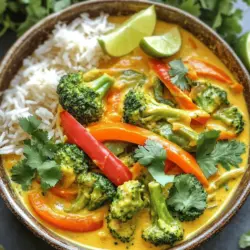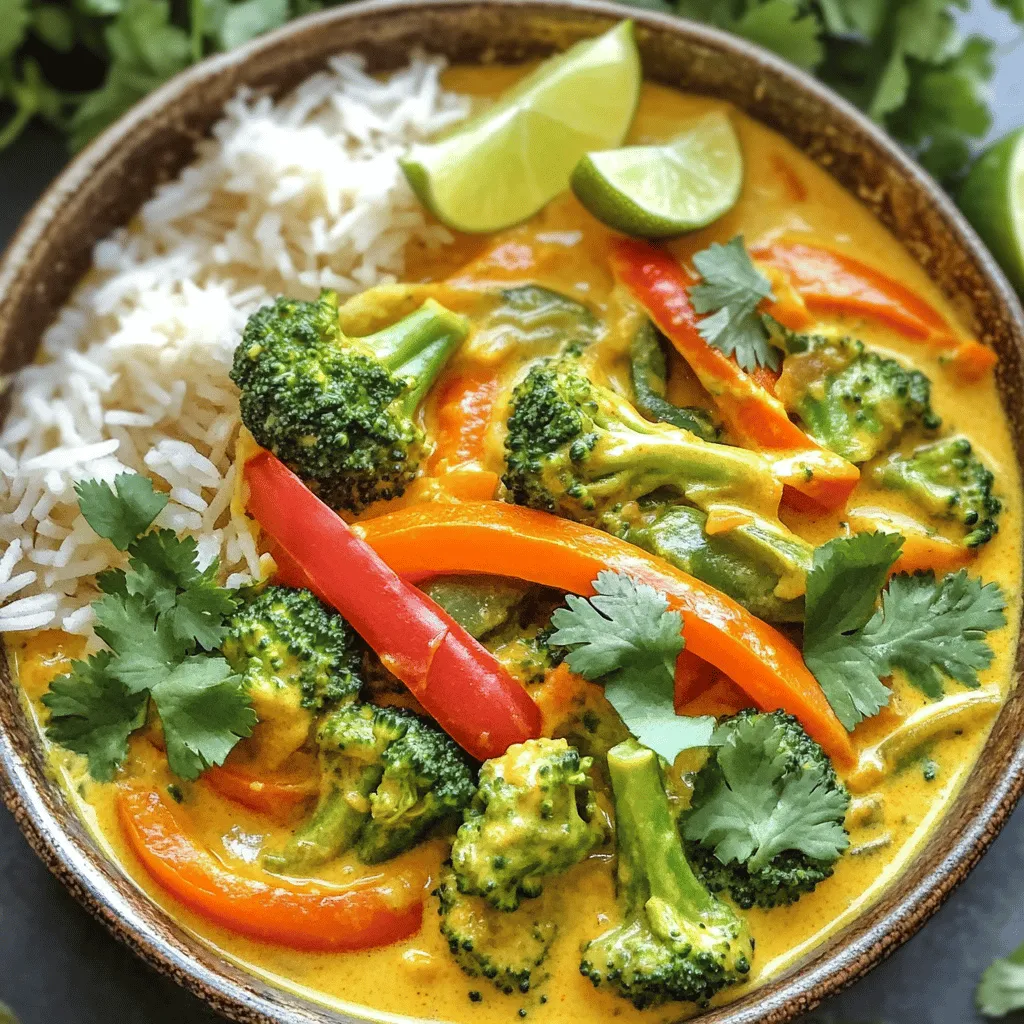Looking for a quick, tasty meal? My Easy Thai Coconut Veggie Curry is just what you need! Packed with vibrant flavors, this dish is simple to make and sure to impress. In this article, I’ll walk you through the ingredients, cooking steps, and helpful tips to elevate your curry game. Whether you’re a beginner or a seasoned cook, this recipe is perfect for busy weeknights or impressing guests. Let’s dive in!
Ingredients
List of Required Ingredients
To make a tasty Easy Thai Coconut Veggie Curry, gather these fresh ingredients:
- 1 tablespoon coconut oil
- 1 onion, finely chopped
- 3 garlic cloves, minced
- 1 tablespoon ginger, grated
- 1 red bell pepper, sliced
- 1 cup broccoli florets
- 1 cup carrots, sliced
- 1 zucchini, diced
- 1 can (400 ml) coconut milk
- 2 tablespoons red curry paste
- 2 tablespoons soy sauce
- 1 tablespoon maple syrup (or honey)
- 1 lime, juiced
- Fresh cilantro, for garnish
- Salt and pepper to taste
These ingredients mix together to create a rich and creamy dish. Each one adds its own unique taste.
Substitutes for Key Ingredients
Sometimes, you may not have all the ingredients. Here are some easy swaps:
- Coconut oil: Use olive oil or vegetable oil instead.
- Coconut milk: Almond milk or soy milk can work, but your curry will taste different.
- Red curry paste: Green curry paste can be a good substitute. It may taste a bit spicier.
- Maple syrup: Honey or agave syrup can replace maple syrup for sweetness.
These substitutes help keep your curry delicious, even if you’re missing something.
Essential Kitchen Tools
To make this curry, you will need a few basic tools:
- A large pot or skillet for cooking
- A cutting board for chopping veggies
- A sharp knife for easy slicing
- Measuring spoons for accurate amounts
- A wooden spoon for stirring
Having these tools ready will make your cooking process smooth and fun.Enjoy cooking!
Step-by-Step Instructions
Detailed Cooking Process
To make this Easy Thai Coconut Veggie Curry, start by gathering your ingredients. This recipe is simple and quick. First, take a large pot or skillet. Heat the coconut oil on medium heat. Add the finely chopped onion. Sauté the onion for about 3-4 minutes until it softens. Next, add the minced garlic and grated ginger. Cook these for 1-2 minutes until they smell great.
Now, it’s time for the veggies! Add the sliced red bell pepper, broccoli florets, sliced carrots, and diced zucchini to the pot. Stir-fry them for around 5-7 minutes. You want them to be bright and slightly tender. Once that’s done, pour in the coconut milk. Add the red curry paste next. Stir the mixture well to blend the flavors.
After mixing, pour in the soy sauce and maple syrup. Let the curry simmer on low heat for 10-15 minutes. This helps all the flavors mix well and makes the veggies tender. When it’s ready, squeeze in the lime juice and season with salt and pepper to taste.
Timing for Each Step
- Heating oil and onions: 3-4 minutes
- Cooking garlic and ginger: 1-2 minutes
- Stir-frying vegetables: 5-7 minutes
- Simmering curry: 10-15 minutes
Total time for this dish is about 30 minutes from start to finish. It’s perfect for a busy night!
Tips for Perfecting Each Stage
- Sautéing: Make sure not to burn the garlic. Stir it well!
- Vegetable choice: Feel free to mix in your favorite veggies.
- Simmering: Keep an eye on the heat. Low and slow is best.
- Taste test: Always taste and adjust seasoning before serving.
This Easy Thai Coconut Veggie Curry will bring joy to your dinner table.
Tips & Tricks
Common Mistakes to Avoid
When making Easy Thai Coconut Veggie Curry, avoid overcooking the veggies. You want them to stay crisp. If they turn mushy, the dish loses its charm. Another mistake is not stirring enough. Stir the mix often to blend flavors and prevent burning on the bottom. Lastly, don’t skip the lime juice. It adds a bright taste that makes a big difference.
Enhancing Flavor Profiles
To boost the taste of your curry, try adding fresh herbs. Thai basil or mint can elevate the dish. You can also use lime zest for extra zing. If you want more depth, consider adding a splash of vegetable broth. It gives a rich base. Remember, taste as you go. Adjust the soy sauce or maple syrup based on your preferences.
Adjusting Spice Levels
If you prefer a mild curry, use less red curry paste. Start with one tablespoon and build up. For more heat, add a chopped chili or more curry paste. Taste and adjust as you go. You can also balance spice with sweetness. A little more maple syrup or honey can help tone down the heat. Always keep a spoon handy to check flavors!

Variations
Adding Protein Options
You can easily boost the protein in your Easy Thai Coconut Veggie Curry. Adding tofu, chickpeas, or lentils works well.
- Tofu: Use firm or extra-firm tofu. Press it to remove excess water, then cube and sauté until golden brown.
- Chickpeas: Canned chickpeas add creaminess and protein. Rinse and drain them before adding to the curry.
- Lentils: Red lentils cook fast. They break down and thicken the curry, adding heartiness.
Vegetarian and Vegan Adjustments
This curry is naturally vegetarian and can be made vegan too.
- Fish Sauce: If you want non-vegetarian flavor, add fish sauce. For a vegan option, use soy sauce or tamari.
- Honey vs. Maple Syrup: Replace honey with maple syrup for a 100% vegan dish.
Seasonal Vegetable Recommendations
Using seasonal vegetables can enhance the flavor and nutrition of your curry.
- Spring: Try asparagus or snap peas for a fresh crunch.
- Summer: Bell peppers, corn, and eggplant add vibrant colors and textures.
- Fall/Winter: Sweet potatoes and squash add warmth and richness.
Experiment with your choices to create your ideal curry!
Storage Info
Best Practices for Storing Leftovers
To keep your Easy Thai Coconut Veggie Curry fresh, allow it to cool first. Once cooled, transfer it to an airtight container. Store it in the fridge for up to three days. This way, you can enjoy the rich flavors later. Make sure to label the container with the date to track freshness.
Reheating Instructions
Reheat the curry on the stovetop for best results. Pour the curry into a pot over low to medium heat. Stir it often to heat evenly. If the curry is too thick, add a splash of water or coconut milk. Heat until it’s warm throughout, about 5-10 minutes. You can also use a microwave. Just place it in a microwave-safe bowl and cover it. Heat in 1-minute intervals, stirring in between until hot.
Freezing and Thawing Tips
You can freeze this curry for later use. Pour the cooled curry into a freezer-safe container. Leave some space at the top for expansion. It will stay good for up to three months. To thaw, move it to the fridge overnight. For a quicker method, run the sealed container under cold water. Once thawed, reheat it as described above. This way, you can enjoy this tasty dish anytime!
FAQs
What can I substitute for coconut milk?
If you need a substitute for coconut milk, try almond milk or oat milk. These options offer a lighter taste. You can also use cashew cream for a richer flavor. Just remember, the curry may taste slightly different. Adjust your spices to match your choice.
Is this recipe suitable for meal prep?
Yes! This easy Thai coconut veggie curry is great for meal prep. Make a big batch and store it in airtight containers. It keeps well in the fridge for up to four days. You can also freeze it for up to three months. When ready to eat, just reheat it on the stove or in the microwave.
How can I make this curry spicier or milder?
To spice up your curry, add more red curry paste. You can also toss in sliced fresh chilies or chili flakes. For a milder dish, reduce the curry paste. You could use less ginger and garlic too. Always taste as you go to find your perfect balance.
In this post, we covered key ingredients, cooking steps, and helpful tips for your recipe. I shared common mistakes to avoid and ways to enhance flavor. You also learned about variations, storage methods, and how to adjust spice levels. Cooking can be fun and rewarding if you follow these steps. I hope you feel ready to create a tasty dish that suits your style and taste. Enjoy the process and happy cooking!

